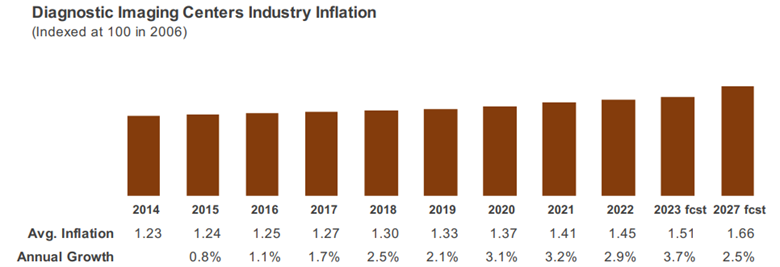The U.S. is currently experiencing some of the highest inflation rates in three decades, impacting virtually every industry. Consumers are feeling the pinch with increasing prices for everyday purchases, while operational executives of diagnostic imaging centers face rising costs and shrinking profit margins. This article explores the effects of inflation on diagnostic imaging centers nationwide and offers strategies to overcome these challenges amidst economic volatility, labor market fluctuations, and supply chain disruptions.
The Inflation Landscape
In recent years, the United States has witnessed an unprecedented surge in inflation rates, affecting the economy on multiple levels. Diagnostic imaging centers are not immune to these fluctuations, as they must contend with increasing expenses and reduced profit margins. As the healthcare landscape evolves, it is essential for these centers to understand and adapt to the new economic reality.

How Rising Inflation Affects Diagnostic Imaging Centers' Operations
Although healthcare inflation has grown at a slower rate than other sectors in recent years, it may soon accelerate due to factors such as:
Interested in learning more about the effects of inflation and current market conditions on U.S. diagnostic imaging centers? Download our complimentary industry report (a $395 value)
1. Higher Labor Costs
Labor costs have surged to their highest levels since 2001, and the ongoing "Great Resignation" shows no signs of abating. With over 4.4 million Americans leaving their jobs in February 2022, diagnostic imaging centers face significant pressure to fill administrative and front office positions while grappling with increased labor costs for both new and existing staff.
- The Impact of Labor Shortages on Diagnostic Imaging Centers
The labor shortages experienced during the Great Resignation have far-reaching consequences for diagnostic imaging centers. With fewer applicants available to fill open positions, centers may need to compete with higher salaries, better benefits, and improved working conditions to attract and retain skilled professionals. This competition drives up labor costs, making it more challenging for centers to maintain profitability.
- Addressing the Skills Gap in Diagnostic Imaging
The skills gap in the healthcare sector further compounds the problem of rising labor costs. As the demand for highly skilled professionals in diagnostic imaging grows, centers must invest in ongoing education and training to ensure their workforce remains competent and up-to-date with the latest industry advancements. These investments contribute to the overall rise in labor costs, adding another layer of complexity to the financial challenges faced by diagnostic imaging centers.
2. Higher Costs of Supplies
Inflation, severe supply chain disruptions, and elevated raw materials costs also contribute to rising prices for office and medical supplies, with paper prices alone experiencing 6% to 15% increases.
- Global Supply Chain Disruptions and Their Impact on Diagnostic Imaging Centers
The COVID-19 pandemic has disrupted global supply chains, resulting in delays and shortages for various goods and services. For diagnostic imaging centers, this means increased costs and potential service disruptions as they struggle to obtain essential supplies, such as medical equipment, pharmaceuticals, and personal protective equipment (PPE). In addition, these supply chain challenges can lead to higher prices for consumers, further straining the financial health of the centers.
- Mitigating the Effects of Supply Chain Disruptions
To cope with supply chain disruptions, diagnostic imaging centers can explore alternative sourcing options, such as local or regional suppliers, to reduce the reliance on global networks. Additionally, centers can collaborate with industry partners and other healthcare providers to share resources and minimize the impact of shortages.
Strategies to Offset the Effects of Healthcare Inflation
As experts predict inflation to continue its upward trend, diagnostic imaging centers must adapt to maintain profitability. The following strategies can help centers navigate the challenges posed by rising inflation:
Interested in learning more about the effects of inflation and current market conditions on U.S. diagnostic imaging centers? Download our complimentary industry report (a $395 value)
1. Optimize and Automate Operations
Leveraging technology to reduce manual labor and create operational efficiencies is crucial. Traditional radiology practice workflows, such as scheduling, physician referrals, and patient engagement, often rely on manual processes, leading to bottlenecks and increased labor costs.
- Implementing Electronic Health Records (EHRs)
EHRs can streamline information management and improve communication among healthcare providers. By adopting a comprehensive EHR system, diagnostic imaging centers can reduce paperwork, minimize errors, and facilitate faster access to patient information, ultimately increasing efficiency and reducing administrative costs.
- Investing in Telemedicine Solutions
Telemedicine allows healthcare providers to deliver services remotely, which can help diagnostic imaging centers optimize resource allocation and improve patient access to care. By integrating telemedicine solutions into their practice, centers can reduce the need for physical office space, lower overhead costs, and enhance the patient experience.
- Utilizing Artificial Intelligence and Machine Learning
AI and machine learning technologies can analyze vast amounts of data, automate repetitive tasks, and support decision-making processes. By incorporating these technologies, diagnostic imaging centers can enhance operational efficiency, reduce human error, and potentially lower labor costs.
2. Minimize Patient No-Shows
Innovative solutions to maximize revenues are essential. Patient no-shows cost medical practices billions of dollars annually. With an industry average no-show rate of 20% for MRIs alone, according to a Risk Management and Healthcare Technology Research Paper, recapturing missed revenue is vital.
- Implementing Automated Patient Engagement Solutions
By using automated patient engagement solutions, diagnostic imaging centers can send appointment reminders, follow-up messages, and personalized patient education materials. These tools not only improve patient satisfaction but also reduce no-show rates, helping to offset the inevitable costs of rising inflation.
- Offering Flexible Scheduling Options
By providing flexible scheduling options, such as extended hours and weekend appointments, diagnostic imaging centers can accommodate patients with busy schedules, potentially reducing no-shows and cancellations.
3. Focus on Value-Based Care
As healthcare shifts towards a value-based model, diagnostic imaging centers can benefit from prioritizing patient outcomes and experiences.
- Enhancing Patient Experience
By improving the patient experience, diagnostic imaging centers can build trust and loyalty, resulting in higher patient retention and positive word-of-mouth referrals. Key areas to focus on include appointment scheduling, wait times, and patient-physician communication.
- Tracking and Reporting Quality Metrics
By monitoring and reporting on quality metrics, diagnostic imaging centers can identify areas for improvement and demonstrate their commitment to high-quality care. This data can be used to negotiate better reimbursement rates with insurers and attract new patients.
4. Diversify Revenue Streams
Diversifying revenue streams can help diagnostic imaging centers mitigate the effects of inflation and increase financial stability.
- Expanding Service Offerings
By offering a broader range of diagnostic and treatment services, centers can attract new patients and generate additional revenue. This diversification may include offering specialized imaging services, preventive care programs, or partnering with other healthcare providers to expand the scope of care.
- Exploring Alternative Payment Models
Diagnostic imaging centers can explore alternative payment models, such as bundled payments or capitated arrangements, to reduce financial risk and increase predictability. These models can help stabilize revenue and encourage more efficient resource utilization.
By implementing these strategies, diagnostic imaging centers can navigate the challenges of rising inflation, optimize operations, and ensure continued growth and success in an increasingly competitive healthcare landscape.







